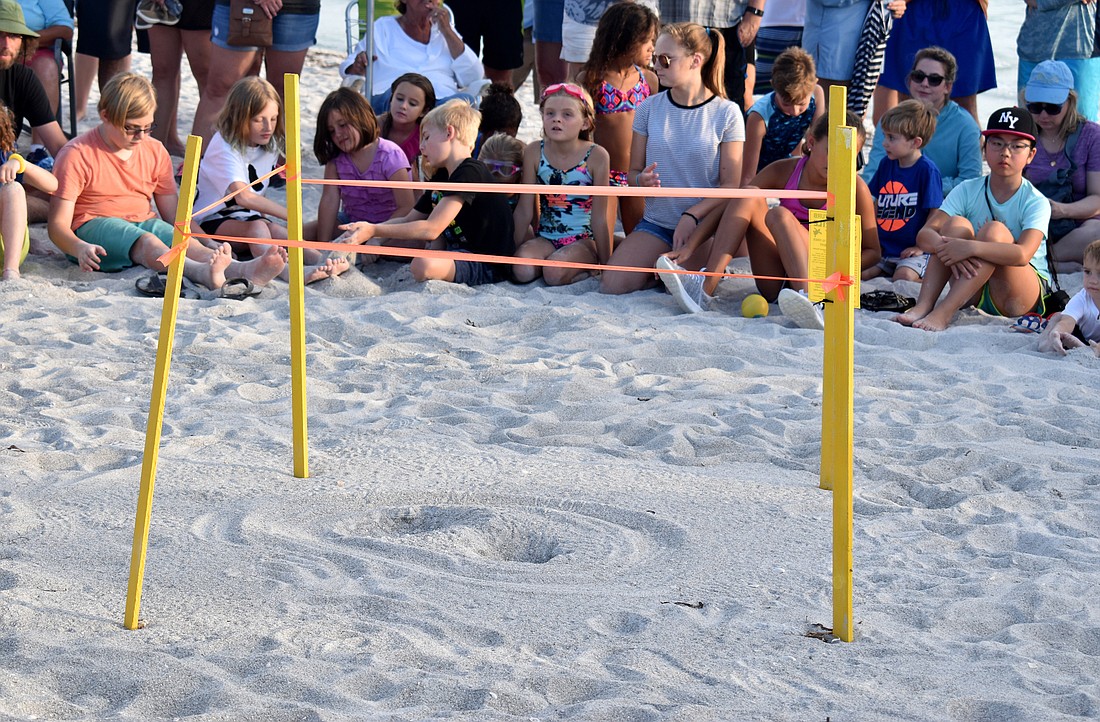- April 25, 2024
-
-
Loading

Loading

As the snowbirds make their trek back to Longboat Key, the turtles say farewell.
The 2018 sea turtle nesting season ended Oct. 31.
This year, Longboat Key was home to 993 nests, down from 1,260 last year.
Across all 35 miles of Mote Marine Laboratory-monitored beaches from Longboat Key to Venice there were 3,151 nest laid between the May and October, Mote Senior Biologist Melissa Bernhard said.
She said out of the 37 years of Mote’s turtle programming, this year was third in terms of nests laid. It follows a record-breaking year in 2016 for all 35 miles and a record-breaking year on Longboat Key in 2017. In 2016, there were 4,588 nests, and in 2017 there were 4,503 nests.
The good news is that the false crawl number dropped this year, too. False crawls are when turtles come ashore but don’t nest.
“You don’t want to have a decrease in nesting number with a high false crawl number,” Bernhard said.
Mote scientists were encouraged by fewer false crawls this season than successful nests (993 to 1,003).
But, there were still some challenges this year.
On Longboat Key, the number of disoriented turtles increased. This year, six adults became disoriented and hatchlings disoriented 164 times, which means they wandered away from the water because of lighting, obstacles or other things that distract them or obstruct them from the water.
“When adults (become disoriented), it’s really bad,” she said. “It takes a lot for the adults to (disorient), where it seems like the hatchlings are more inclined to if there’s something out there.”
In addition, Longboat Key nests had the challenge of wandering coyotes, which harmed 25 nests, Longboat Key Turtle Watch Vice President Cyndi Seamon said.
In total, 203 nests on Longboat were harmed by predators, which could be animals such as raccoons, dogs and coyotes. Turtle Watch volunteers assessed the paw prints to figure out which animals were the culprit.
One morning, a Turtle Watch volunteer was walking from North Shore Drive and spotted a coyote with its head in the nest, Seamon said.
Longboat Key Code Enforcement Officer Christopher Elbon said there was an increase in code enforcement and code violations this year compared to last year. There were 73 cases opened last year and 92 opened in 2018.
The majority of those violations, he said, came from condominium lighting from common areas.
Elbon said he has reached out to the Sea Turtle Conservancy to host a lighting workshop ahead of next nesting season.
Elbon said it is possible the violation numbers increased because enforcement increased. Citations were implemented this year and were given to violators who did not immediately fix their violation if they could, such as turning off a balcony or interior light. Other cases received notices if violations took a bit longer to fix, such as changing light bulbs.
The decrease in this year’s nesting numbers could come for a variety of other factors. Bernhard said because there was such a large increase in nests from 2015 to 2016, she isn’t surprised the turtles couldn’t sustain the pattern.
“Last year was more of an education of the ordinance, and this year is more of an enforcement of the ordinance,” Elbon said.
“We basically saw doubling in our numbers over the course of that season, so to have it kind of level back off, I’m not worried,” Bernhard said.
She said before any caution flags are pulled out, they will look at data for the coming two years.
The effects the late summer bloom of red tide had on turtles is unclear, Bernhard said. She said nesting females and hatchlings were not really seen in the strandings.
“That doesn’t mean that they weren’t being affected, but the way turtles are usually affected by red tide has to do with consuming food that’s contaminated, and nesting turtles aren’t usually feeding in between nesting,” Bernhard said.
Seamon said Turtle Watch never found a hatchling washed back ashore during the red tide bloom. This could be due in part to the fact that hatchlings don’t eat until they reach the weed line, and red tide might not be there.
Early in turtle nesting season, Tropical Storm Alberto came through the area, but few nests were lost. Likewise, Hurricane Michael’s winds came late in turtle season and didn’t cause much damage, Bernhard said. When Michael hit Florida, there were fewer than 100 nests left on Mote-monitored beaches.
Another factor that can play into the decline is that turtles tend to take a year or two off after they nest. So the turtles that nested in 2016 or 2017, might not be nesting this year.
Despite these obstacles, Bernhard said it was a relatively uneventful year, which could be due in part to the fact that not many tropical storms affected the area.
“Overall, trends are going up,” Bernhard said. “And green turtles have this really unique pattern. They have a big year, then a small year, and that’s seen at a local level and state level, so we knew this year going into it that green nests were going to be lower.”
Bernhard said Mote scientists think trends might be going upward due to the timing of when turtles were put on the endangered species list and programs, like Mote’s, started about 35 years ago.
“Turtles take about 25 to 30 years to mature, which means (some) turtles were hatchlings when the Endangered Species Act (began), when our program began and others,” she said. “The turtles were given more protection, so they were able to reach maturity, and now those turtles are adults.”